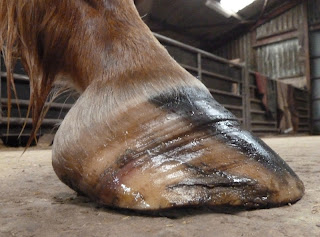When I first experimented with taking the shoes off my horses (and like many owners I tried it because there were no other options left) I honestly thought that going barefoot (and of course a "barefoot trim") was the answer.
Taking shoes off seemed to be the last piece of the jigsaw - but how wrong I was!
Over the years its become increasingly common - as barefoot has become more popular - for people to email me or post on forums a comment like: "My horse has been barefoot for x months and its still not right" or "I tried barefoot but it was no good for my horse".
Like me all those years ago, these people thought barefoot worked like a magic wand - you take the shoes off and bingo, everything sorts itself out.
I suspect this blog may be partly responsible for people having that impression because they see the rehab horses here improve fairly consistently, but here is the point:
Taking a horse barefoot isn't the last piece of the jigsaw, its just the tip of the iceberg.
Once shoes are off horses' feet
can (and often do) change radically - but its not inevitable that they will do so.
Nutrition
The foundation for any successful barefoot horse is good nutrition and this is one area where we've made huge progress. At the time "Feet First" came out, most people thought that "barefoot" was a type of trim. The book was an attempt to give owners a more accurate picture of what factors influence hoof health and practical ideas on how to improve the health of their own horses' feet.
Many were initially sceptical about how big an impact diet has on feet, but trial and error - and seeing the effect on their own horses - made most owners well aware of its importance.
However, even nutrition isn't the last piece of the puzzle.
Biomechanics
Right from the early years I have had rehab horses who arrived out of shoes but with ongoing lameness problems. Often vets and even owners say something like "Its already barefoot and its still lame so how is what you do any different?"
The common denominator among the horses who arrive here - whether shod or barefoot - is that their biomechanics are compromised. Generally, horses are landing toe first and/or have poor medio-lateral balance; naturally some have nutritional/metabolic issues too, which complicate things further, but the biomechanical problems are common to all of them and its these that have led to the "navicular", DDFT and other injuries that are then diagnosed.
The hype about "barefoot" has grown a lot in the last few years and there are still people (like the ones quoted above) who think its all about taking the shoes off. They are then puzzled when the same lameness persists out of shoes - but the answer generally is that the biomechanical problems have not been resolved and so the damage and injuries persist.
Someone called me only the other day about their 4 year old horse which went lame in shoes with a "navicular" diagnosis. He had improved somewhat after she had taken the shoes off but was far from 100%. Her words were "You hear all these stories about barefoot successes so I don't know why its not working for my horse."
I haven't seen the horse, but since she had already sorted out his nutrition, its most likely that the horse's biomechanics were still compromised - the way he was moving was still causing stress or injury.
Believe it or not, its possible for barefoot horses to have biomechanical issues, just as its possible for shod horses to be perfectly sound. It all depends on how the horse is loading his feet and whether he is landing correctly. That in turn depends on the strength of the horse's hooves and how he is affected by trimming or shoeing.
So what's the point of this post? Its just a reminder...Don't lose sight of the whole horse. Its a very complex puzzle and there is no one aspect which will give you all the answers.
Nutrition is vital - but its one part of the puzzle. Feet are vital - but they are one part of the puzzle. Movement is vital - but its one part of the puzzle. Good biomechanics are vital - but they are one part of the puzzle. Fair and correct training is vital - but its one part of the puzzle. A good environment is vital - but its one part of the puzzle. Well-fitting tack is vital - but its one part of the puzzle. You get the idea!
What you will find is that if these aspects are individually right, then you will gradually get a "virtuous circle" of improvements - in health, in behaviour, in ridden work. What is less successful (though its easier in the short term especially if you are confident in one field and not in the others) is to focus on one aspect to the exclusion of the others. A magic wand would be much simpler - if only life were like that!




























































